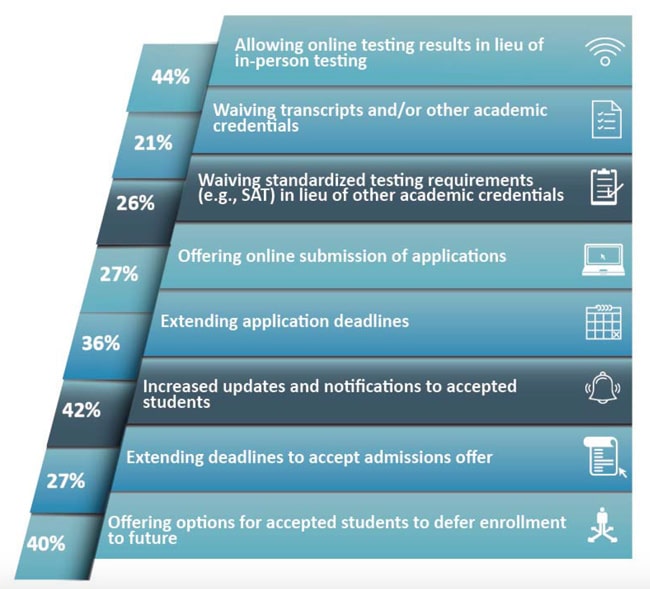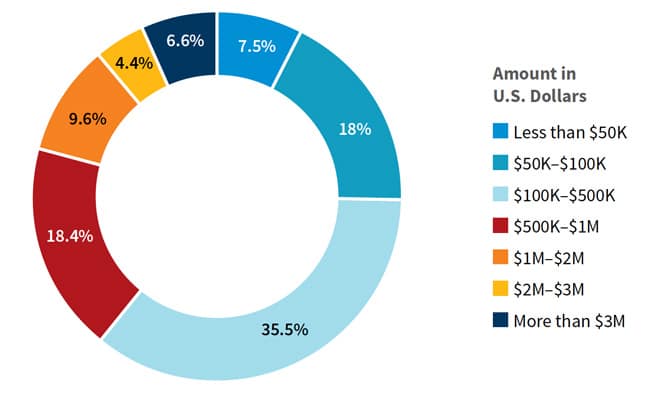Projecting COVID-19’s impact on US higher education this fall
- Most international students enrolled in US higher education have remained in the US during the pandemic lockdown
- The vast majority of US institutions have put additional support services in place for visiting students, and have introduced more flexible admissions processes for 2020/21
- Even so, most institutions project a decline in international student numbers for fall 2020
- A related study estimates the virus’ direct financial impact on US higher education at more than US$4.5 billion
A newly released survey from the Institute of International Education (IIE) provides some fresh insights on how the pandemic is affecting US universities and colleges, and especially with respect to fall enrolment.
The latest report in the IIE’s Snapshot Survey Series gathers responses from 599 US institutions, which collectively enrolled just under 520,000 international students in 2018/19 (or roughly half of the total foreign enrolment in the US that year).
The survey finds that most foreign students enrolled in US higher education this spring were already in the United States as the pandemic hit, and as American campuses began to close. Nearly all responding institutions (99.5%) shifted instruction online at that point, and many began to offer expanded support services to foreign students.
At the time of the survey – which was in the field from 16 April through 1 May – 92% of all international students that were then enrolled at responding institutions remained in the US, whether on campus or in alternate housing. IIE notes that the size of the institution appears to have played a part in student retention: “Large institutions were more likely to offer housing options to their students, and as such, more significant numbers of students stayed. The largest institutions (20,000 students and above) reported that between 0% and 20% of their students had left. In contrast, only three institutions reported that 100% of their international students had left, and these were all small institutions with less than 5,000 students.”
More than eight in ten respondents also reported providing expanded communications and supports specifically for international students, as summarized in the chart below.

Plans for fall
Looking ahead to fall, nearly nine in ten responding colleges (85%) say they have not yet made a decision as to whether instruction will be in-person or online (or blended delivery) in the coming academic year.
Meanwhile, most respondents reported having cancelled recruitment travel (63%) and/or events (57%). Nearly eight in ten (78%) said that they have undertaken virtual outreach to incoming or prospective students through education agents, via virtual tours, or by means of webinars or other online events.
Nearly all respondents (84%) said that they have also put new measures in place for international admissions in order to spur recruitment for this fall.

Even with that additional flexibility and supports in place, nearly nine in ten US institutions expect that their international enrolment will decrease for the 2020/21 academic year. Roughly one-third of respondents (30%) anticipate a “substantial decrease”, 42% project “some decrease”, and 16% forecast a “slight decrease”.
Nearly three quarters (70%) say they expect some international students will not be able to come to campus in the fall, whether because of visa processing issues or travel restrictions, or other issues. And three in four say that they are giving student the option to defer enrolment, either to later in the fall or to spring 2021.
“When asked about the long‐term challenges of international education on their campus, most respondents considered several different areas of consideration,” said Dr Mirka Martel, Head of Research, Evaluation & Learning for IIE. “They would like to see greater clarity on travel restrictions to help their decision‐making on future semesters. They are concerned about support for international education on their campuses, especially in the face of budget cuts or financial strain. Finally, they are thinking about internationalisation moving forward, and how international education may change and evolve post‐COVID‐19.”
The missing US$4.5 billion
A related study from NAFSA reinforces the forecast for this fall. Nearly eight in ten (78%) responding institutions to a recent NAFSA survey anticipate enrolment declines for the coming academic year.
“With travel restrictions, visa delays, and economic instability worldwide, COVID-19 has been incredibly harmful to the field of international education,” said Esther D. Brimmer, Executive Director and CEO of NAFSA: Association of International Educators.
“We need Congress to support legislation protecting international education to save American jobs and ensure US students remain globally competitive at time where we cannot afford to lose our competitive edge.”
The projected financial impact of this declining foreign enrolment is significant. NAFSA’s analysis estimates that US institutions have already lost US$1 billion due to shortened or canceled study abroad programmes, and spent another US$638 million in emergency financial support for visiting students, scholars, faculty, and staff. The additional impact of falling international student numbers this fall is projected at roughly US$3 billion. The direct projected impacts in the coming fiscal year, therefore, total more than US$4.5 billion.

“A decline in international student enrolments at HEIs in the United States will force institutions to revise international student enrolment management strategies, but they will take time to rebuild – most likely several years,” notes the IIE report. “HEIs across the United States are reducing staff hours, eliminating staff positions and introducing furloughs to recoup current losses, and bracing for future shortfalls.”
In a related brief to the US Congress, NAFSA urges government intervention to provide emergency support to the international education sector, and to help ensure its quick recovery when the pandemic subsides. Its recommendations are wide-ranging and include targeted funding assistance for the sector, streamlined visa processing for 2020/21, competitive student visa policies, and the formation of a national strategy “to attract and retain international students and scholars.”
For additional background, please see:
- “US immigration review raises new concerns for H-1B and OPT programmes”
- “US: COVID-19 impacts include campus closures and recruiting challenges”
- “New insights on how international students are planning for the coming academic year”
- “Looking ahead: Scenario planning and recovery forecasts for international education”
















